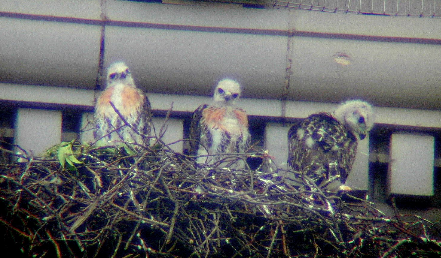He's at it again. The shameless stud who has fathered 25 since 1995 is about to mate with his newest gal pal, Xena. This male is so shameless you can find him in flagrante delicto on the Fifth Avenue apartment terraces above Central Park. This is Pale Male, New York City's most famous Red-Tailed Hawk.

Pale Male with lunch (Photos Courtesy of Ric Davis)
Up until last Sunday, Pale Male was living with Ginger (or Lima, depending on who you talk to because the NYC hawk watchers are a pretty contentious group and don't always agree on a hawk's name). Whatever this female hawk's name, two things were clear: she had been the babe in Pale Male's life for a year until she ate a poisoned rat last weekend and was found dead beneath a tree in Central Park.
Did Pale Male grieve? Heck no. One day later, he was seen flying around Central Park with a new female the hawk watchers are now calling Xena and who is acting exactly like the warrior princess for whom she is named.
"Pale Male just snapped his wings and she appeared," says photographer and hawk watcher Ric Davis. Davis keeps a daily vigil at Central Park's Conservatory Water with two gigantic Swarovski telescopes trained on Pale Male's nest. "Pale Male's a movie star now," Davis says. "Xena appeared almost immediately the next day, and the two of them are now on the nest, tending to business together."
There are few New Yorkers who haven't heard of Pale Male, though the majority of them have a tough time keeping up with his exploits. This red-tailed hawk came to NYC in 1991 to hunt and discovered the abundant food in Central Park (pigeons, rats, mice, birds, squirrels, and raccoons). Birders arrived to watch the hawk including author of Red Tails in Love, Marie Winn, who named the hawk Pale Male because of his white breast. Pale Male had the run of the entire city and perched wherever he chose, including on the balcony of Woody Allen's Fifth Avenue apartment across the street from the 72nd Street Conservatory Water of Central Park. (Allen has since moved).
A year later, a female hawk arrived in NYC who ignored Pale Male until he presented her with the gift of a dead pigeon. She was smitten. They mated several times a day and the hawk watchers called her First Love; but she did not produce any chicks. A year later, First Love disappeared. The following year, Pale Male had a new female, Chocolate. For the next two years, Chocolate laid eggs, but none hatched. Then a new female mated with Pale Male and three chicks hatched in April on the ledge of a building 150 feet in the air. The chicks had never before seen a tree, but somehow, after much wing flapping and false starts, all three eyasses managed to successfully fledge and flew to tree branches in Central Park. They survived.

Three Eyasses of Pale Male
In January 2002, Pale Male found a new mate, Lola. Pale Male built a nest on the ledge of 927 Fifth Avenue (East 74th Street), NYC's "Gold Coast." This co-op building, where Mary Tyler Moore lived, was so exclusive that the Board had rejected Barbara Streisand, fearful that she'd throw too mny parties. Pale Male liked his open Penthouse above a top-story window because it faced southwest, protecting it against the winds and because it was beneath a cornice, protecting it from the rain. For meals, Pale Male needed only to swoop down into Central Park, grab his pray, and return to the nest.
Over the next three years, Pale Male and Lola had chicks, which died. On December 7, 2004, the Board of 927 Fifth Avenue, tired of seeing blood and pigeon bones in front of their entrance, removed Pale Male's nest. The hawk watchers, the Central Park birding community, and the NYC Audubon Society staged impassioned protests, picketing in front of the building, disrupting traffic, and holding up signs saying HONK FOR HAWKS. Mary Tyler Moore joined in. After a week, The Board agreed to install a new cradle for the hawk's nest.
Three weeks later, Pale Male and Lola rebuilt their nest. That March, the hawk watchers waited for the eggs to hatch, but at the end of May, the hawks abandoned the nest. Still, this wasn't the end of the story. The following spring, the hawks returned to the nest and more eggs hatched. The eyasses fledged. Then, in December 2010, Lola disappeared. A year ago, a new female hawk appeared who some hawk watchers called Ginger and others called Lima. And that's the one who died last week from eating a poisoned rat.
If you go to the hawk watchers bench in Central Park, you'll be able to look through Ric Davis' telescopes trained on the nest and perhaps see Xena and Pale Male mating. In about a month's time, hopefully Xena will be sitting on eggs in the nest and you'll see Pale Male deliver food to her but he'll leave it away from the nest (so it doesn't harm the eggs). Then, Pale Male will switch places and sit on the eggs so Xena can eat. And if you time it right and you're very very lucky, maybe you'll even see the chicks fledge.
If you're curious about the birds who inhabit Central Park, walk a short distance to the Boathouse where the Bird Book lists daily bird sightings. You'll be surprised by the kinds of numbers of birds who call Manhattan home.